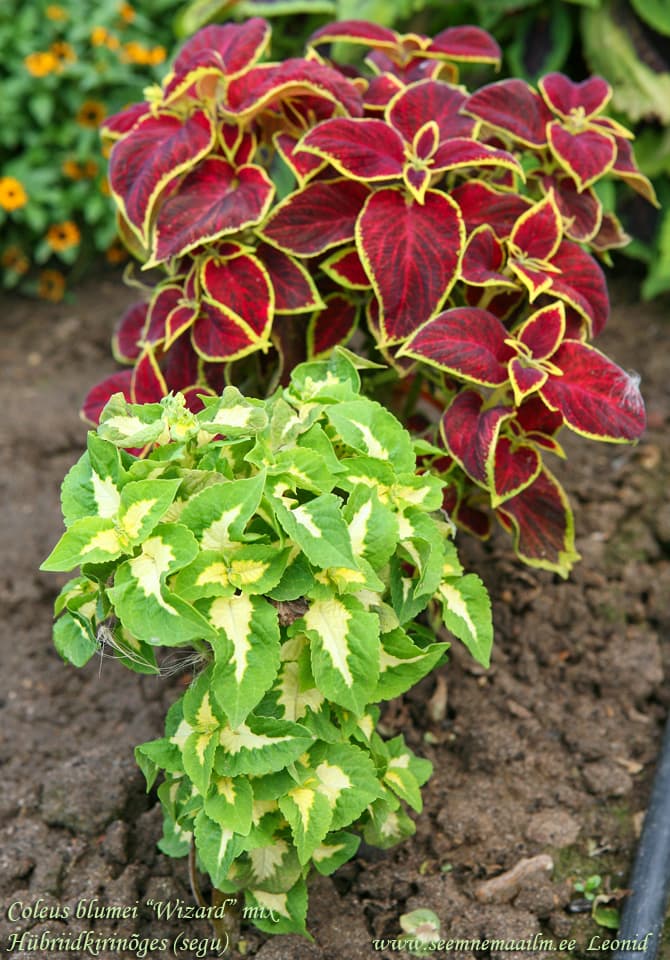Discover the beauty of the play of colors and shapes of the amazing coleus!
A lush, colourful outfit is beautiful even without flowers. It will ideally act as a backdrop for gardens with perennials, and it is also wonderful as a soloist on the lawn. It will retain its beauty throughout the season and will delight the eye until frost sets in.
Agrotechnics.
Sowing: March-May for seedlings. Once the plants have grown enough for the pattern to be visible, the best ones are replanted, maintaining a distance of 15-20 cm between plants.
Care: prefers open sunny places with non-acidic soil. To get a lush bush, pinch the growing shoots of a young plant, do this several times.
Loves light, but should not be planted in areas exposed to direct sun during the hottest part of the day. The plant needs abundant watering and periodic feeding in the spring and summer with complex mineral fertilizer.
Flowering: summer and autumn. The flowers are small, collected in a sparse complex inflorescence.
Eng.: Flame Nettle, Painted Nettle, Painted Leaf, Poor Mans Croton. Bot. syn.: Solenostemon scutellarioides (L.), Soleirolia blumei (Benth.).
Location: Coleus grow quickly. They require a sheltered, sunny or diffused shade location.
Soil: light, permeable, rich, slightly acidic.
Care: consists of regular and abundant watering and spraying. Otherwise, coleus easily becomes prey for spider mites, and indoors also for scale insects and whiteflies. In addition, it is necessary to carry out regular, formative pruning, in which elongated shoots are cut out, giving the plants a compact shape. Constant feeding is also required every 12-14 days, in June with nitrogen, and later with full mineral fertilizer with microelements.
Propagation: cuttings and seeds. Small seeds (3500 pieces in 1 g) are sown at the end of winter in a mixture of leaf, peat, turf soil and sand (1: 1: 1: 1). The crops are sprinkled with sand, pressed and kept at a temperature of +20+22°C in constant moisture. Shoots appear in 14-18 days. As soon as it becomes possible to pick them up, they are planted in the same soil mixture, according to the 2 5 2 cm pattern. Later they are planted in pots with a diameter of 7-8 cm. The seedlings are grown in a cooler mode, good ventilation and constant watering with wetting of the leaves. When the seedlings grow to 10 cm in height, they are pinched for better branching. Coleus is planted in place in the ground, in boxes, containers or vases in June, after the end of return frosts, which it does not tolerate. In the ground, the distance between plants is 20-30 cm.
The plants you like, grown from seeds, are transplanted into pots with a clod of earth in the fall before frost, the shoots are shortened by 1/3 and brought onto a glassed-in veranda with a temperature no higher than +15°C, and then indoors. They don’t water as much as in summer, but they don’t dry out either. Closer to spring, the pots are moved to a warm, well-lit place, watered and fed.
The emerging young shoots can be used for cuttings. They are planted in pots with soil and sand poured on top, put on a transparent film bag and shaded. Roots appear in 8-12 days. Rooted cuttings are planted in pots, the tops are pinched and further grown as seedlings. The mother plant is usually not used in the second year, since young plants grown from seeds or cuttings develop better.
Use: in the garden, coleus is planted as a border plant along the edge of a flower bed. Its variegated or monochromatic leaves create a densely colored stripe that is well suited to plants of a different appearance, for example: with small flowers in openwork inflorescences and small or feathery leaves (gypsophila, common kermek), or to plants with linear leaves (lilies, daylilies , liatris, crocosmia). Coleus is usually planted in containers or vases by combining plants of different shapes and leaf colours. Coleus in pots is suitable for well-ventilated rooms, open terraces and patios.
An ideal plant for beginners: it is unpretentious, grows quickly, and reproduces easily.













